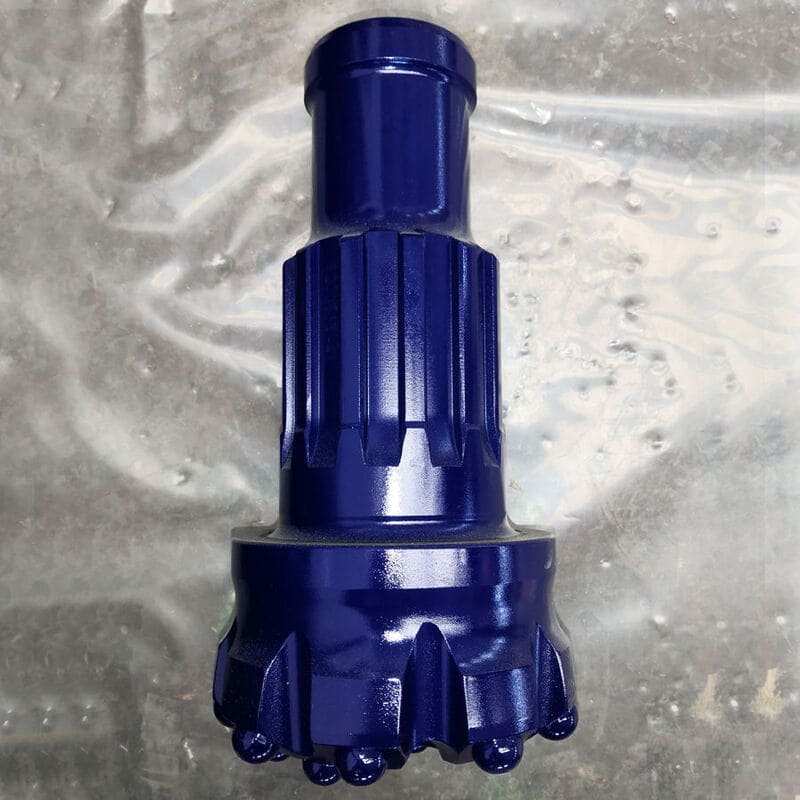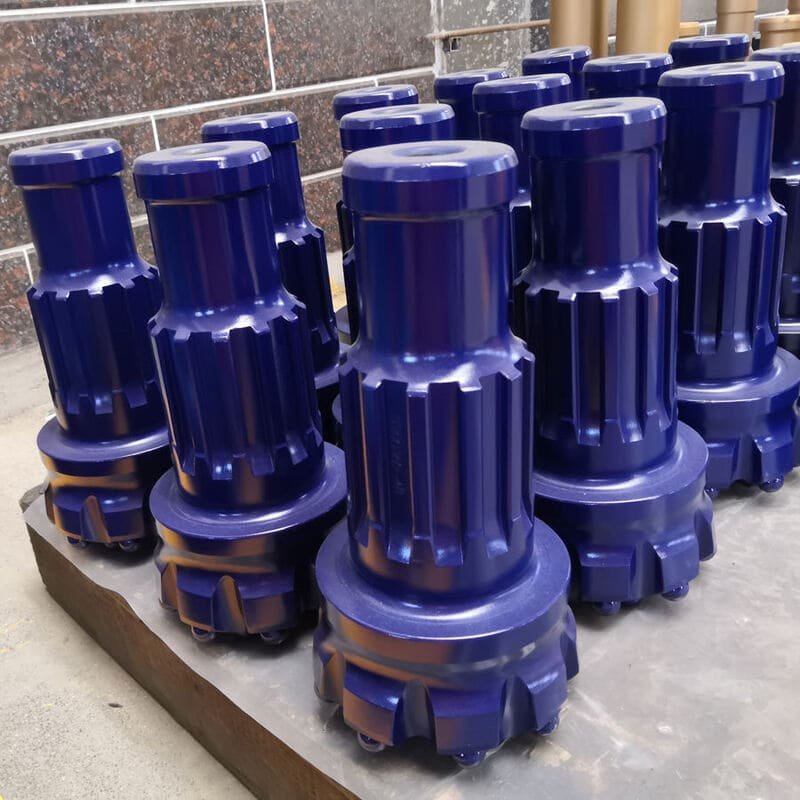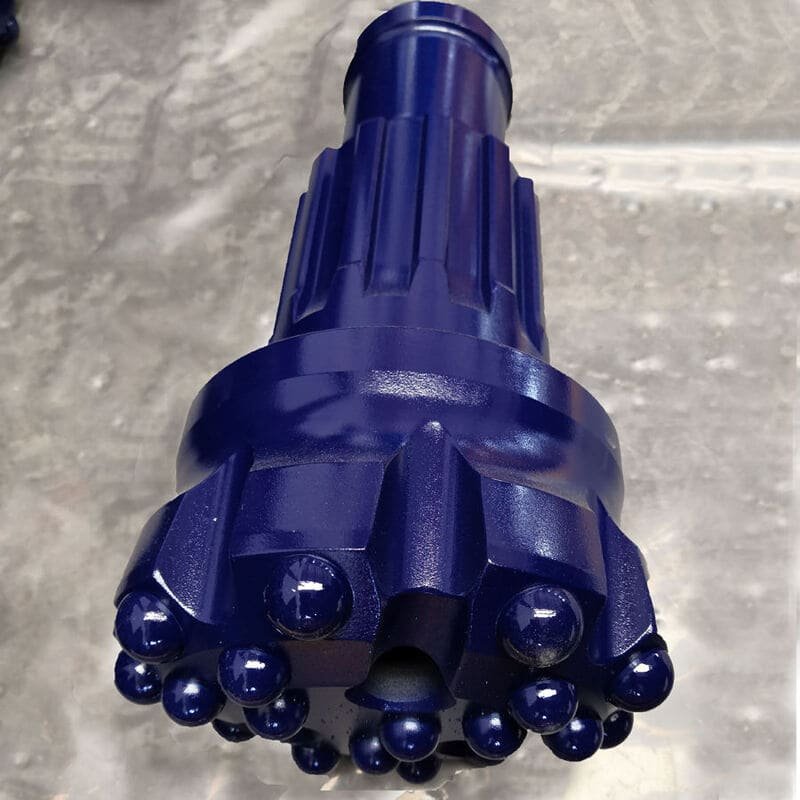Ever wondered why tungsten carbide DTH drill bits carry such a hefty price tag?
Tungsten carbide DTH drill bits are pricey due to their premium materials, intricate manufacturing, and unparalleled performance. The high cost is driven by the rare and expensive tungsten metal, complex sintering and machining processes, and their remarkable durability that minimizes replacement needs.
I remember when I first encountered the steep price of tungsten carbide drill bits. It was a bit of a shock, but diving deeper into the reasons behind the cost opened my eyes. Imagine investing in something that doesn't just last longer but performs consistently under tough conditions. The rare tungsten metal, the detailed sintering process, and the precision machining make these bits a powerhouse in drilling. Once you get past the initial sticker shock, you'll find they often save more money in the long run by cutting down on replacements and maintenance. Curious if they're worth it for your needs? Let's explore what makes them tick.
Tungsten carbide drill bits use rare metals.True
Tungsten carbide is made from tungsten, a rare and costly metal.
The manufacturing process of tungsten carbide bits is simple.False
The process involves advanced sintering and machining, making it complex.
What Materials Are Used in Tungsten Carbide DTH Drill Bits?
Have you ever wondered what makes tungsten carbide DTH drill bits so incredibly tough and reliable? It's all in the materials!
Tungsten carbide DTH drill bits are crafted from tungsten carbide powder combined with a metal binder, typically cobalt or nickel. This mix offers unparalleled hardness and durability, perfect for the toughest drilling scenarios.

I remember the first time I held a tungsten carbide DTH drill bit. It felt like I was gripping a piece of engineering marvel, crafted to slice through the Earth's toughest layers. The secret to this resilience lies in its unique composition.
Composition of Tungsten Carbide
Tungsten carbide, the primary component of these drill bits, is a composite material. It's made from tungsten or tungsten carbide powder mixed with a binder metal. The common binders used are cobalt and nickel due to their ability to enhance the toughness of the compound.
| Component | Description |
|---|---|
| Tungsten Carbide | Provides the hard, wear-resistant qualities. |
| Cobalt/Nickel | Acts as a binder to hold the carbide particles together, adding toughness. |
Material Properties
The magic of tungsten carbide is in its dual nature—hard as rock yet resilient enough to withstand impact. It ranks around 8.5 to 9 on the Mohs scale, which means it's only slightly less hard than a diamond! This makes it perfect for drilling through stubborn rock layers without needing constant replacements.
- Hardness: Maintains sharpness under extreme conditions.
- Wear Resistance: Prolongs service life by reducing wear and tear.
Manufacturing Process
Creating these drill bits is a meticulous process:
- Powder Production: Tungsten and carbon are mixed under high temperatures to produce tungsten carbide powder.
- Mixing: The powder is blended with a metal binder.
- Sintering: This involves pressing the mixture into a mold and heating it to a temperature where particles fuse but do not melt.
- Machining: Finally, precision machining gives the bits their final shape.
Discover more about sintering processes1
Role of Binder Metals
While tungsten carbide provides hardness, it's the binder metals like cobalt and nickel that add necessary toughness and flexibility. These metals allow the bits to absorb shocks and impacts during drilling operations, thus preventing fractures.
- Cobalt: Offers superior binding strength and thermal resistance.
- Nickel: Adds corrosion resistance, ideal for wet environments.
Understanding the importance of binder metals2 can help you select the best bit for your specific drilling needs.
Applications in Various Industries
Tungsten carbide DTH drill bits are essential across several industries due to their unmatched efficiency in cutting through hard materials:
- Mining: Ideal for breaking through hard rock layers.
- Construction: Used in foundation drilling where precision is crucial.
- Oil and Gas: Essential for deep well drilling operations.
Explore the variety of DTH drill bits3 available for different geological challenges.
Tungsten carbide is softer than diamond.True
Tungsten carbide ranks 8.5-9 on the Mohs scale, while diamond is 10.
Cobalt increases the hardness of tungsten carbide.False
Cobalt acts as a binder, enhancing toughness, not hardness.
How Does the Manufacturing Process Affect Costs?
Ever wonder how the nuts and bolts of manufacturing can play a big role in your product's price tag?
Manufacturing processes shape costs through choices in materials, complexity, labor, and technology. Streamlined methods cut waste and boost productivity, directly affecting overall expenses.

Material Selection and Costs
Material selection can feel like standing in front of a buffet, wondering if choosing the filet mignon will really be worth it over the chicken nuggets. High-quality materials, like tungsten carbide for drill bits4, may be pricey upfront due to their hardness and durability. But I’ve seen firsthand how they save bucks in the long run by reducing replacement needs.
| Material Type | Cost Implication |
|---|---|
| High-Quality | Increased upfront costs but reduced long-term expenses |
| Low-Quality | Lower initial costs but higher replacement needs |
Complexity of Production Processes
When it comes to production processes, it’s like putting together a 1,000-piece puzzle versus a 100-piece one. More complex processes such as sintering5 and precision machining add to the cost layers. Sintering, for instance, demands precise temperature control, which can be time-consuming and costly. It reminds me of when I tried baking a soufflé—one wrong move, and it all comes tumbling down.
- Sintering Process: Requires precise temperature management.
- Precision Machining: Demands specialized tools and skilled labor.
Labor and Technological Impact
The impact of labor is like deciding whether to hire movers or to bribe friends with pizza. Labor-intensive processes are typically pricier due to higher wages, whereas automation can cut those costs by enhancing efficiency and reducing errors. Investing in automated systems6 may pinch your wallet initially, but it’s akin to buying a reliable car that saves on gas in the long run.
- Manual Labor: Higher costs associated with human labor.
- Automation: Initial investment but potential for long-term savings.
Waste Management and Cost Efficiency
Every efficient manufacturing process is a bit like a well-organized kitchen: minimizing waste is key. Techniques such as lean manufacturing7 focus on cutting waste and optimizing processes, which leads to lower production costs and better profit margins. I once revamped my cluttered garage into a functional workspace, and the savings on time and frustration were immense.
- Waste Reduction: Lower material usage leads to cost savings.
- Process Optimization: Enhances efficiency, reducing operational expenses.
Understanding these aspects helps businesses fine-tune their manufacturing processes for cost-effective operations. It's like being a conductor of an orchestra—every decision impacts the harmony and success of the final performance.
High-quality materials reduce long-term costs.True
They offer durability, reducing replacement frequency, saving costs.
Automation increases initial costs but saves in the long run.True
Automation enhances efficiency, reducing labor costs over time.
Why Is Tungsten Carbide Preferred for Drilling Applications?
Ever wondered why tungsten carbide drill bits are the go-to choice for tough jobs?
Tungsten carbide is favored in drilling due to its incredible hardness and wear resistance, ensuring longer life and efficiency in challenging conditions. Its durability cuts down on replacements and maintenance, making it a cost-effective choice over time.

The Unmatched Hardness and Durability
I remember the first time I learned about tungsten carbide's toughness. It was during a project where nothing else seemed to pierce through the relentless rock beneath us. Rated between 8.5 to 9 on the Mohs scale, it's this very hardness that keeps drill bits8 sharp, cutting down on the frequency of replacements. Each time I use them, I can almost hear my budget breathing a sigh of relief.
| Property | Tungsten Carbide |
|---|---|
| Hardness | 8.5-9 Mohs |
| Density | 15.63 g/cm³ |
| Melting Point | 2,870°C |
Enhanced Performance in Extreme Conditions
Imagine being on site with the sun beating down, and you're facing abrasive materials9 that seem determined to wear down your tools. That's where tungsten carbide shines. Its wear resistance is unmatched, letting industries like mining and construction thrive without constant tool changes. Faster penetration rates? Absolutely.
Cost-Effectiveness Over Time
Sure, tungsten carbide drill bits might have you wincing at their initial price tag. But trust me, when you factor in their longevity and the reduced need for maintenance, you're looking at significant savings. It's like buying quality shoes—more expensive upfront but saving you money in the long run.
Adaptability to Diverse Drilling Needs
It's like having a tool that listens to you—a little dramatic, I know, but that's how it feels when tungsten carbide adapts to specific drilling needs. Customized designs mean no more "one-size-fits-all" frustrations. It's perfect for tackling unique geological challenges or meeting those demanding project requirements.
Industry Demand and Advancements
The continuous demand, especially from oil and gas sectors, has driven innovations in tungsten carbide applications. I find it fascinating how advancements, like coating technologies10, keep pushing its performance boundaries, ensuring its place as a modern drilling essential.
Tungsten carbide is harder than most metals.True
With a hardness of 8.5-9 on the Mohs scale, it surpasses most metals.
Tungsten carbide drill bits are cheaper initially.False
They have a higher initial cost but save money over time due to durability.
How do tungsten carbide drill bits compare to other types?
Have you ever wondered how tungsten carbide drill bits measure up against other options?
Tungsten carbide drill bits stand out for their incredible hardness and durability, making them perfect for tough materials like metal and concrete. Compared to high-speed steel or cobalt bits, they last longer and drill faster, offering great efficiency for demanding projects.

Material Composition and Durability
When it comes to selecting the right drill bit, I often think back to those early days of tackling a DIY project with my dad. We’d fumble around with the toolbox, debating which bit to use. Now, as I dive deeper into the world of drill bits, tungsten carbide emerges as a champion in durability. These bits are a composite of tungsten carbide powder and a binder like cobalt, making them incredibly tough. It's like having a trusty sidekick that you know won’t let you down when you're drilling through steel or concrete.
In comparison, high-speed steel (HSS) bits are more like the beginner's best friend—cost-effective but not quite as long-lasting. They tend to wear out quicker, much like my old sneakers after a few too many hikes.
| Drill Bit Type | Material | Durability |
|---|---|---|
| Tungsten Carbide | Composite of tungsten carbide and binder | High |
| HSS | Steel alloy | Moderate |
| Cobalt | Alloy with cobalt | Higher than HSS |
Learn more about drill bit materials11
Performance in Extreme Conditions
If you've ever been halfway through a project only to have your drill bit fail you, you'll appreciate the heat resistance of tungsten carbide bits. They hold their sharpness even under high temperatures—a real lifesaver when you're in the thick of things. Think of it as having your morning coffee stay hot all day long! In contrast, HSS bits can dull pretty quickly when things heat up. Cobalt bits offer a good middle ground but still don't quite match the resilience of tungsten carbide.
Applications:
- Tungsten Carbide: Ideal for drilling into masonry, cast iron, and stainless steel.
- HSS: Best suited for softer materials like wood and plastic.
- Cobalt: Performs well in stainless steel and titanium applications.
Explore applications of tungsten carbide bits12
Cost Considerations and Lifespan
I once balked at the upfront cost of tungsten carbide drill bits, but looking back, it was one of those "worth every penny" moments. Yes, they’re pricier initially, but their longevity means fewer replacements over time—a bit like investing in a quality coat that lasts you several winters. For heavy-duty tasks where precision is key, spending a little more upfront on these bits can be a smart move.
- Initial Cost: Higher than HSS and cobalt.
- Lifespan: Significantly longer, reducing frequency of replacements.
Consider the long-term cost benefits13 when choosing drill bits.
Versatility and Specialized Use
Tungsten carbide bits are like the Swiss Army knife of drill bits—versatile across industries from construction to mining. They really shine in applications demanding both hardness and longevity. Yet, if you're just doing some general-purpose drilling or working with softer materials, HSS bits are often more than sufficient. Cobalt offers that extra bit of toughness without going full throttle on tungsten carbide.
Find out about different types of drill bits14 for specialized use cases.
Tungsten carbide bits are less durable than HSS bits.False
Tungsten carbide bits are more durable due to their composite material.
Cobalt bits offer better heat resistance than tungsten carbide.False
Tungsten carbide bits have superior heat resistance compared to cobalt.
Why Choose Tungsten Carbide Bits for Long-Term Use?
Imagine a tool so tough, it's almost as hard as diamond. That's tungsten carbide bits for you! They're the secret weapon for anyone serious about drilling, offering durability and efficiency that make them worth every penny.
Tungsten carbide bits are a powerhouse for long-term use, thanks to their unmatched durability and cost-effectiveness. Their exceptional hardness keeps them sharp longer, ideal for challenging tasks and saving you money over time.

Enhanced Durability and Wear Resistance
Every time I pick up a tungsten carbide bit, I can't help but think of all the grueling tasks it can handle without breaking a sweat. These bits are renowned for their incredible hardness—ranking just shy of diamonds on the Mohs scale. When I first started using them in my projects, I was blown away by how long they stayed sharp, even after tackling tough materials. This kind of endurance means fewer replacements and less downtime, which is a huge relief for anyone managing a tight schedule or budget.
For industries like mining and construction, this durability15 translates into significant savings in both time and money.
Cost-Effectiveness Over Time
I'll admit, I was initially hesitant about the upfront cost of tungsten carbide bits. But looking back, the savings I've seen from reduced replacements and minimal downtime have been more than worth it. They deliver consistent performance, making them a smart investment for any project that demands reliability in tough environments. It's like buying peace of mind!
While tungsten carbide bits may have a higher initial cost compared to other materials, their extended lifespan offers significant long-term cost savings.
Efficiency in Challenging Applications
If you're like me and often find yourself facing challenging drilling conditions, you'll appreciate the speed at which these bits work. They cut through hard rock formations faster than anything else I've used, trimming labor costs and accelerating project timelines.
The inherent properties of tungsten carbide allow for faster penetration rates, especially in hard rock formations. Additionally, tungsten carbide bits16 require less maintenance, further boosting their cost-effectiveness.
Application Versatility
One thing I love about tungsten carbide bits is their versatility. Whether I'm working on a mining project or construction site, these bits perform consistently across different applications. They're reliable allies, ensuring precision and dependability regardless of the task at hand.
Tungsten carbide bits are versatile across various drilling applications from mining to construction.
| Property | Benefit |
|---|---|
| Hardness | Prolonged sharpness and minimal wear |
| Cost | Savings on replacements and downtime |
| Efficiency | Faster drilling rates |
| Versatility | Applicable across multiple industries |
Sustainability Considerations
As someone who values sustainability, it's reassuring to know that using tungsten carbide bits aligns with eco-friendly practices. Their longevity reduces the frequency of disposal, minimizing environmental impact.
Using tungsten carbide bits can contribute to sustainability goals by reducing the frequency of bit disposal. For anyone aiming to enhance their environmental footprint17, investing in durable materials like tungsten carbide is a step in the right direction.
Tungsten carbide bits rank 9 on the Mohs scale.False
Tungsten carbide ranks 8.5-9 on the Mohs scale, not exactly 9.
Tungsten carbide bits are cost-effective long-term.True
Their durability reduces replacement needs, saving money over time.
Are Tungsten Carbide Drill Bits a Wise Investment?
I remember the first time I tried tungsten carbide drill bits—it was like discovering a secret weapon! These powerful tools offer unmatched durability and precision. But are they really worth the investment? Let's dig into what makes them so special.
Tungsten carbide drill bits boast remarkable hardness and wear resistance, perfect for tough drilling jobs. While their upfront cost is higher, their extended lifespan and minimal downtime often make them more economical over time than alternatives.

The Material Advantage
Picture this: I’m on site, drilling into what feels like the world's toughest rock, and my tungsten carbide bit is cutting through it like butter. That's the magic of this composite material—made from tungsten and a binder metal like cobalt. Its incredible wear resistance18 keeps it sharp even in the harshest conditions.
| Property | Tungsten Carbide | Steel |
|---|---|---|
| Hardness (Mohs) | 8.5 to 9 | 4 to 4.5 |
| Wear Resistance | High | Moderate |
| Cost Efficiency | Long-term savings | Higher wear |
Performance and Durability
Every time I use these bits, I marvel at how quickly they cut through hard surfaces. This means projects wrap up faster, saving me time and labor costs. Plus, the durability factor is a game-changer; fewer replacements mean less downtime.
- Drilling Speed: Enhanced penetration rates speed up project timelines19.
- Durability: They handle extreme conditions, slicing through materials like steel and concrete effortlessly.
Cost-Effectiveness Analysis
Initially, I hesitated at the higher price tag, but I've found that investing in tungsten carbide bits saves money in the long run due to less maintenance and fewer replacements.
- Initial Investment: Yes, they're pricier upfront.
- Maintenance Needs: You'll notice a drop in how often you need to replace or maintain them compared to other options20.
Market Demand and Applications
In industries like mining and construction, these bits are heroes. Their reliability in tough applications has made them a staple for precision and longevity.
- Industry Usage: Essential for mining, construction, and oil and gas drilling.
- Customization Options: You can tailor designs to specific geological challenges.
When weighing their benefits against costs, consider your project's specific needs. This can help determine if tungsten carbide drill bits align with your goals and budget.
Tungsten carbide bits have higher wear resistance than steel.True
Tungsten carbide's wear resistance is superior to steel, reducing replacements.
Steel drill bits are more cost-effective long-term than tungsten carbide.False
Despite higher initial costs, tungsten carbide's durability offers long-term savings.
Conclusion
Tungsten carbide DTH drill bits are expensive due to high-quality materials, complex manufacturing processes, and exceptional durability, offering long-term cost savings through reduced maintenance and replacements.
-
Learn about sintering, a crucial step in tungsten carbide production, enhancing the material's strength. ↩
-
Understand how binder metals like cobalt and nickel improve toughness and performance. ↩
-
Discover various DTH drill bits suited for specific drilling challenges. ↩
-
Explore why investing in tungsten carbide drill bits might be cost-effective in the long run. ↩
-
Understand how the sintering process impacts manufacturing efficiency and costs. ↩
-
Discover how automation can reduce labor costs and improve efficiency in manufacturing. ↩
-
Learn about lean manufacturing principles for reducing waste and improving process efficiency. ↩
-
Discover how tungsten carbide drill bits maintain sharpness and enhance drilling efficiency. ↩
-
Learn about the unique properties of tungsten carbide that make it highly resistant to abrasion. ↩
-
Find out about new coating technologies enhancing the performance of tungsten carbide tools. ↩
-
Understand the different materials used in crafting drill bits to assess their suitability for various tasks. ↩
-
Discover the specific applications where tungsten carbide drill bits excel for better-informed tool selection. ↩
-
Explore the long-term economic advantages of using tungsten carbide drill bits despite their higher initial cost. ↩
-
Learn about various drill bit types to choose the right tool for your drilling needs. ↩
-
This link provides insights into the durability factors of tungsten carbide bits compared to other materials. ↩
-
Discover how tungsten carbide bits enhance drilling speed and efficiency in various applications. ↩
-
Explore the environmental benefits of using tungsten carbide bits in sustainable drilling practices. ↩
-
Understand the chemical composition that grants tungsten carbide its exceptional wear resistance. ↩
-
Discover how this material accelerates penetration rates, enhancing efficiency. ↩
-
Learn about the lower maintenance requirements compared to other bit materials. ↩








